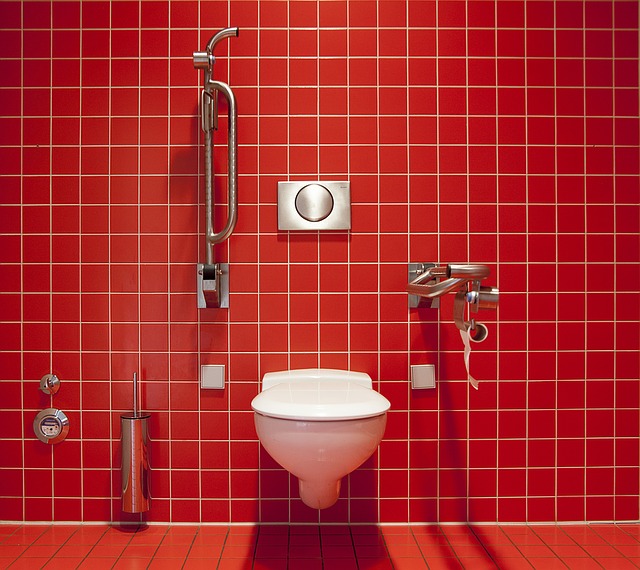Lavatory
In modern usage, the term ‘lavatory’ (UK pronunciation: ‘lavah-tree’) describes a room or cubicle containing sanitaryware or other receptacles for the passing of human waste. The sanitaryware will usually be connected to a public drainage system.
When used to describe a room, a lavatory may also contain other sanitaryware, such as a bath, shower, urinal or bidet. Other ancillary facilities may typically include wash-hand basins, hot air dryers, towels and mirrors.
The term lavatory is sometimes used synonymously:
- Toilet
- WC (although this more correctly refers to the water closet sanitaryware itself)
- Bathroom (if it contains a bath)
- Loo
- Washroom
- Ladies / gents
- Sanitary convenience
- Powder room
Historically, a lavatory was a cistern or trough where the inmates of monastic establishments could wash their hands and faces, as well as their surplices and vestments.
See Lavatorium.
In southern Germany, lavatories took on grander functions that resembled those of baptistries. They would be either square or octagonal chambers to the side of a cloister and would have a series of water troughs for washing arranged around a fountain located centrally in the room.
The term lavatory was also given to a ‘piscina’ – a drain that was originally connected to Roman aqueducts but which later was applied to a stone basin near a church altar.
Legal requirements for sanitary conveniences, washing facilities and bathrooms are set out in Part G of the building regulations, with solutions to common situations described in Approved Document G (Sanitation, hot water safety and water efficiency).
NB The Scottish Building Standards, Part I. Technical Handbook – Domestic, Appendix A Defined Terms, defines a toilet: ‘…an enclosed part of a storey which contains a watercloset, a waterless closet or a urinal, which are properly installed for use.’
[edit] Related articles on Designing Buildings
- Approved Document G.
- Bidet.
- Cistern.
- Earth closet.
- ECA Water Scheme.
- Garderobe.
- Gas fired toilet.
- Inclusive design.
- Lavatorium.
- Macerating toilet systems.
- Passive water efficiency measures.
- Sanitary accommodation.
- Sanitaryware.
- Shared toilet facilities.
- Shower.
- Sink.
- Solid surface wash troughs.
- Types of sanitary appliances.
- Urinal.
- Wall hung toilet.
- Water closet.
- Wet room.
Featured articles and news
A change to adoptive architecture
Effects of global weather warming on architectural detailing, material choice and human interaction.
How big is the problem and what can we do to mitigate the effects?
Overheating guidance and tools for building designers
A number of cool guides to help with the heat.
The UK's Modern Industrial Strategy: A 10 year plan
Previous consultation criticism, current key elements and general support with some persisting reservations.
Building Safety Regulator reforms
New roles, new staff and a new fast track service pave the way for a single construction regulator.
Architectural Technologist CPDs and Communications
CIAT CPD… and how you can do it!
Cooling centres and cool spaces
Managing extreme heat in cities by directing the public to places for heat stress relief and water sources.
Winter gardens: A brief history and warm variations
Extending the season with glass in different forms and terms.
Restoring Great Yarmouth's Winter Gardens
Transforming one of the least sustainable constructions imaginable.
Construction Skills Mission Board launch sector drive
Newly formed government and industry collaboration set strategy for recruiting an additional 100,000 construction workers a year.
New Architects Code comes into effect in September 2025
ARB Architects Code of Conduct and Practice available with ongoing consultation regarding guidance.
Welsh Skills Body (Medr) launches ambitious plan
The new skills body brings together funding and regulation of tertiary education and research for the devolved nation.
Paul Gandy FCIOB announced as next CIOB President
Former Tilbury Douglas CEO takes helm.
UK Infrastructure: A 10 Year Strategy. In brief with reactions
With the National Infrastructure and Service Transformation Authority (NISTA).
Ebenezer Howard: inventor of the garden city. Book review.
Airtightness Topic Guide BSRIA TG 27/2025
Explaining the basics of airtightness, what it is, why it's important, when it's required and how it's carried out.























Comments
Quite informative. It’s good to know more about the lavatory from reading this piece of content before we finally proceed with the construction. Thanks!